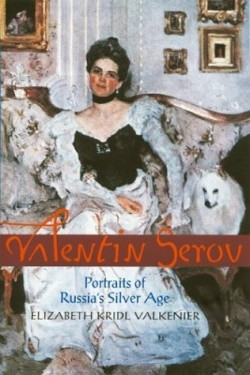Valentin Serov
Portraits of Russia's Silver Age
The author characterizes Russia’s Silver Age as the period in the early twentieth century when the country’s culture and art evolved from critical realism to aestheticism, and the “pyrotechnic outburst of Russian modernism” occurred. To illustrate the events and personalities involved in this transition, she has focused on the work of noted artist Valentin Serov (1865-1911), who was well received and influential in the prevailing art circles of the time, and who had painted portraits of many prominent patrons, artists, musicians, actors, and dancers.
Selecting from Serov’s paintings, Valkenier assembles a portrait gallery of Silver Age notables, whom she introduces one by one as the story unfolds. A resident scholar at Columbia University’s Harriman Institute, Valkenier’s acquaintance with the subjects of the portraits, gleaned from primary sources like letters and journals, makes her an ideal gallery guide.
An early luminary is Savva Mamontov, a railroad tycoon who was greatly interested in cultural pursuits and had the means to host an artistic entourage at his summer estate each year. Those gathered were “dedicated to reading and discussion, to painting and music, to the folk art revival, to amateur theatricals, exuberance, and just plain fun,” enthused a participant in 1892. This remark was made by another portrait personality, Sergei Diaghelev, who later led his own artistic circle, an outgrowth of his early association with Mamontov, who had encouraged his interest in theater and dance.
The book includes drawings and sketches, which add intimate character and wit to the depiction of the era. A caricature of Wanda Landowski, a harpsichordist and member of the Society of Free Aesthetics, is a devilishly delicious example. It shows a three-quarter back view of a woman in black, poised like a cat upright on its haunches, forepaws (arms) with claws extended, leaning over a keyboard, and the train of her gown forming what looks suspiciously like a tail.
Students of Russian culture and art history will be most grateful to have an account of the period written in English. They will also appreciate that the author has infused the sometimes overwhelming amount of information with the spirit of excitement, of confidence, and the sense of creative energy that was characteristic of the time.
Reviewed by
Joyce Moore
Disclosure: This article is not an endorsement, but a review. The publisher of this book provided free copies of the book to have their book reviewed by a professional reviewer. No fee was paid by the publisher for this review. Foreword Reviews only recommends books that we love. Foreword Magazine, Inc. is disclosing this in accordance with the Federal Trade Commission’s 16 CFR, Part 255.

